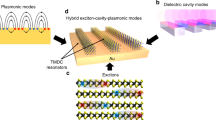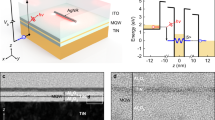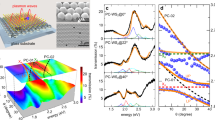Abstract
Localized surface plasmon resonances (LSPRs) typically arise in nanostructures of noble metals1,2 resulting in enhanced and geometrically tunable absorption and scattering resonances. LSPRs, however, are not limited to nanostructures of metals and can also be achieved in semiconductor nanocrystals with appreciable free carrier concentrations. Here, we describe well-defined LSPRs arising from p-type carriers in vacancy-doped semiconductor quantum dots (QDs). Achievement of LSPRs by free carrier doping of a semiconductor nanocrystal would allow active on-chip control of LSPR responses. Plasmonic sensing and manipulation of solid-state processes in single nanocrystals constitutes another interesting possibility. We also demonstrate that doped semiconductor QDs allow realization of LSPRs and quantum-confined excitons within the same nanostructure, opening up the possibility of strong coupling of photonic and electronic modes, with implications for light harvesting, nonlinear optics, and quantum information processing.
This is a preview of subscription content, access via your institution
Access options
Subscribe to this journal
Receive 12 print issues and online access
$259.00 per year
only $21.58 per issue
Buy this article
- Purchase on Springer Link
- Instant access to full article PDF
Prices may be subject to local taxes which are calculated during checkout




Similar content being viewed by others
References
Hutter, E. & Fendler, J. Exploitation of localized surface plasmon resonance. Adv. Mater. 16, 1685–1706 (2004).
Jain, P. K., Huang, X., El-Sayed, I. & El-Sayed, M. Noble metals on the nanoscale: Optical and photothermal properties and some applications in imaging, sensing, biology, and medicine. Acc. Chem. Res. 41, 1578–1586 (2008).
Atwater, H. A. & Polman, A. Plasmonics for improved photovoltaic devices. Nature Mater. 9, 205–213 (2010).
Kneipp, K. et al. Single molecule detection using surface-enhanced Raman scattering (SERS). Phys. Rev. Lett. 78, 1667–1670 (1997).
Willets, K. & Van Duyne, R. Localized surface plasmon resonance spectroscopy and sensing. Annu. Rev. Phys. Chem. 58, 267–297 (2007).
Alvarez, M. M. et al. Optical absorption spectra of nanocrystal gold molecules. J. Phys. Chem. B 101, 3706–3712 (1997).
Pérez-Juste, J., Pastoriza-Santos, I., Liz-Marzán, L. M. & Mulvaney, P. Gold nanorods: Synthesis, characterization and applications. Coord. Chem. Rev. 249, 1870–1901 (2005).
Kanehara, M., Koike, H., Yoshinaga, T. & Teranishi, T. Indium tin oxide nanoparticles with compositionally tunable surface plasmon resonance frequencies in the near-IR region. J. Am. Chem. Soc. 131, 17736–17737 (2009).
Williams, C. R. et al. Highly confined guiding of terahertz surface plasmon polaritons on structured metal surfaces. Nature Photon. 2, 175–179 (2008).
Kundu, J., Le, F., Nordlander, P. & Halas, N. J. Surface enhanced infrared absorption (SEIRA) spectroscopy on nanoshell aggregate substrates. Chem. Phys. Lett. 452, 115–119 (2008).
Norris, D. J., Efros, A. L. & Erwin, S. C. Doped nanocrystals. Science 319, 1776–1779 (2008).
Potter, R. W. An electrochemical investigation of the system copper-sulphur. Econ. Geol. 72, 1524–1542 (1977).
Du, X. et al. Shape-controlled synthesis and assembly of copper sulfide nanoparticles. Cryst. Growth Des. 8, 2032–2035 (2008).
Ghezelbash, A. & Korgel, B. A. Nickel sulfide and copper sulfide nanocrystal synthesis and polymorphism. Langmuir 21, 9451–9456 (2005).
Li, S. et al. Synthesis and assembly of monodisperse spherical Cu2S nanocrystals. J. Colloid Interface Sci. 330, 483–487 (2009).
Sigman, M. B. et al. Solventless synthesis of monodisperse Cu2S nanorods, nanodisks, and nanoplatelets. J. Am. Chem. Soc. 125, 16050–16057 (2003).
Han, W. et al. Synthesis and shape-tailoring of copper sulfide/indium sulfide-based nanocrystals. J. Am. Chem. Soc. 130, 13152–13161 (2008).
Wu, Y., Wadia, C., Ma, W. L., Sadtler, B. & Alivisatos, A. P. Synthesis and photovoltaic application of copper(I) sulfide nanocrystals. Nano Lett. 8, 2551–2555 (2008).
Zhao, Y. et al. Plasmonic Cu2S nanocrystals: Optical and structural properties of copper-deficient copper(I) sulfides. J. Am. Chem. Soc. 131, 4253–4261 (2009).
Evans, H. T. Jr Djurleite (Cu1.94S) and low chalcocite (Cu2S): New crystal structure studies. Science 203, 356–358 (1979).
Sands, T. D., Washburn, J. & Gronsky, R. High resolution observations of copper vacancy ordering in chalcocite (Cu2S) and the transformation to djurleite (Cu1.97 to 1.94S). Phys. Status Solidi A 72, 551–559 (1982).
Tsu, R., Howard, W. E. & Esaki, L. Optical and electrical properties and band structure of GeTe and SnTe. Phys. Rev. 172, 779–788 (1968).
Mulder, B. J. Optical properties and energy band scheme of cuprous sulphides with ordered and disordered copper ions. Phys. Status Solidi A 18, 633–638 (1973).
Alivisatos, A. P. Semiconductor clusters, nanocrystals, and quantum dots. Science 271, 933–937 (1996).
Luther, J. M., Zheng, H., Sadtler, B. & Alivisatos, A. P. Synthesis of PbS nanorods and other ionic nanocrystals of complex morphology by sequential cation exchange reactions. J. Am. Chem. Soc. 131, 16851–16857 (2009).
Grozdanov, I. & Najdoski, M. Optical and electrical properties of copper sulfide films of variable composition. J. Solid State Chem. 114, 469–475 (1995).
Putnis, A. The transformation behaviour of cuprous sulphides and its application to the efficiency of CuxS–CdS solar cells. Phil. Mag. 34, 1083–1086 (1976).
Lukashev, P., Lambrecht, W. R. L., Kotani, T. & van Schilfgaarde, M. Electronic and crystal structure of Cu2−xS: Full-potential electronic structure calculations. Phys. Rev. B 76, 195202 (2007).
Roseboom, E. H. Jr Djurleite, Cu1.96S, a new mineral. Am. Mineral. 47, 1181–1184 (1962).
Gurin, V. S. et al. Sol–gel silica glasses with nanoparticles of copper selenide: Synthesis, optics and structure. Int. J. Inorg. Mater. 3, 493–496 (2001).
Deka, S. et al. Phosphine-free synthesis of p-type copper(I) selenide nanocrystals in hot coordinating solvents. J. Am. Chem. Soc. 132, 8912–8914 (2010).
Mansour, B. A., Demian, S. E. & Zayed, H. A. Determination of the effective mass for highly degenerate copper selenide from reflectivity measurements. J. Mater. Sci. Mater. Electron. 3, 249–252 (1992).
Sadtler, B. et al. Selective facet reactivity during cation exchange in cadmium sulfide nanorods. J. Am. Chem. Soc. 131, 5285–5293 (2009).
Zhang, J., Tang, Y., Lee, K. & Ouyang, M. Tailoring light-matter-spin interactions in colloidal hetero-nanostructures. Nature 466, 91–95 (2010).
Lee, J., Hernandez, P., Lee, J., Govorov, A. O. & Kotov, N. A. Exciton-plasmon interactions in molecular spring assemblies of nanowires and wavelength-based protein detection. Nature Mater. 6, 291–295 (2007).
Oulton, R. F. et al. Plasmon lasers at deep subwavelength scale. Nature 461, 629–632 (2009).
Akimov, A. V. et al. Generation of single optical plasmons in metallic nanowires coupled to quantum dots. Nature 450, 402–406 (2007).
Acknowledgements
Work on copper sulphide nanocrystal synthesis and optical and structural characterization was supported by the Physical Chemistry of Semiconductor Nanocrystals Program, KC3105, Director, Office of Science, Office of Basic Energy Sciences, of the United States Department of Energy under contract DE-AC02-05CH11231. Work on LSPR response characterization, chemical tuning, and vacancy density profiling was supported by a Miller Fellowship awarded to P.K.J. We thank J. Owen, J. B. Rivest and J. van de Lagemaat for discussions and Lam-Kiu Fong for a CdS nanorod sample.
Author information
Authors and Affiliations
Contributions
J.M.L. and P.K.J. contributed equally to this work. J.M.L. synthesized copper sulphide quantum dots and performed optical characterization. P.K.J. performed work on LSPR characterization and assignment; Cu(I)S crystallography and vacancy profiling; and active chemical tuning of LSPRs. T.E. performed electron microscopy of copper sulphide nanocrystals. J.M.L., P.K.J., T.E., and A.P.A. discussed results and prepared the manuscript and subsequent revisions.
Corresponding author
Ethics declarations
Competing interests
The authors declare no competing financial interests.
Supplementary information
Supplementary Information
Supplementary Information (PDF 550 kb)
Rights and permissions
About this article
Cite this article
Luther, J., Jain, P., Ewers, T. et al. Localized surface plasmon resonances arising from free carriers in doped quantum dots. Nature Mater 10, 361–366 (2011). https://doi.org/10.1038/nmat3004
Received:
Accepted:
Published:
Issue Date:
DOI: https://doi.org/10.1038/nmat3004
This article is cited by
-
Dual-plasmonic Au@Cu7S4 yolk@shell nanocrystals for photocatalytic hydrogen production across visible to near infrared spectral region
Nature Communications (2024)
-
Localised surface plasmon resonance inducing cooperative Jahn–Teller effect for crystal phase-change in a nanocrystal
Nature Communications (2023)
-
Plasmonic Copper: Ways and Means of Achieving, Directing, and Utilizing Surface Plasmons
Plasmonics (2023)
-
Optimized Preparation of CuS@SiO2 Core-Shell Nanoparticles with Strong LSPR Absorption and Excellent Photostability for Highly Efficient Solar-driven Interfacial Water Evaporation
Chemical Research in Chinese Universities (2023)
-
Cross-scale modulation for aqueous fabrication of monodisperse Cu2−xE (E = S, Se, Te) nanocrystals and supraparticles
Nano Research (2023)



